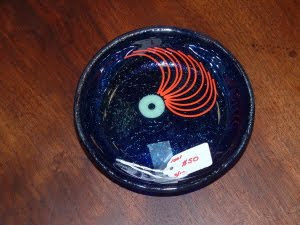This week, we'd like to introduce Jack Spinks. Jack is an accomplished metal-smith, who happens to prefer working in Sterling Silver. Most of his pieces are hand-fabricated. However, he also likes to use unusual casting methods, like broom-straw casting and ice-casting to create unusual and natural shapes to serve as his starting-point or platform for his creative processes.
How did you get started in jewelry-making?
I got started when my eldest son was about to ask his girlfriend to become his wife. I had been buying old antique silver rings and she had really liked one I had given her as a gift. My son wanted something unusual but was on a budget. He found one of my rings that was unusual and asked if I could get it re-sized. I found few jewelers that wanted to touch silver so I pulled out some books, read up on it, and taught myself silver-smithing by resizing that first ring. Of course he then wanted to replace the stones with darker amethysts and I found a 1 ct Songea Ruby from Tanzania to set in amongst them. Much more effort on that first ring than I would have to spend now but the results were worth it since the young lady is now my daughter-in-law.
What is your favorite medium or technique?
Probably my favorite style is filigree in conjunction with large stones. I note that most folks only wear costume jewelry in plastic due to the high cost of genuine stones. I often obtain 10 to 100 ct stones and mount them on filigree and put relatively low prices on them. Mostly I just sell the silverwork and the stone goes for only slightly over what I paid for it. Thus average people can afford really impressive jewelry.
What has been your most satisfying moment as an artist?
Not sure if that was my daughter-in-law's ring, or when I remarried a couple of years later and my fiance told me to get to work and make our wedding rings. We still get comments about the fact they are an unusual style and I have recently made rings and wedding jewelry for several friends and relatives that have gotten married. Very satisfying when you deliver and see faces light up with surprise and appreciation.
What has been your most challenging skill to master?
The most difficult technique has been learning to cut my own faceted stones and devise suitable mountings for them. Being able to cut my own stones specifically for sparkle has been rewarding in that several have been mistaken for diamonds and it drastically enhances the appearance of the piece. The most difficult silver technique has been without question the making of Mokume Gane which I use for pendants in designs not commonly available.
How much time and materials are required to complete a typical piece?
I don't think I have an average time to complete since I rarely do the exact same item twice but it rarely takes under two hours to complete an item, sometimes as much as a day. I only gain time when I am making what for me is a production run. Then I may make 5 or 10 basic shapes prior to customizing each one with different designs and stones.



















